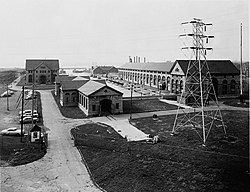Company history
Niagara Falls Hydraulic Company
In 1852, Caleb Smith Woodhull and his associates purchased the land and the water rights from the heirs of the Porter brothers with the intention to build a canal, and in 1853 formed the "Niagara Falls Hydraulic Company." A grant was obtained from the owners of a strip of land 100 ft. wide extending from a point above the upper rapids to the high bank below the Falls. [4] The company started with the construction of the canal in 1853 but stopped after sixteen months [5] because construction costs of the canal significantly exceeded estimates and the company went bankrupt. [3]
Niagara Falls Water Power Company
In 1856, Stephen N. Allen bought the company, which was renamed the "Niagara Falls Water Power Company." The company completed the entrance and river portion of the canal by 1857, [3] with the exception of a narrow extension at the south end of the basin which was completed in 1881. [4]
Niagara Falls Canal Company
In 1860, Horace H. Day purchased the company and renamed it the "Niagara Falls Canal Company." At an investment of $1.5 million, [2] (equivalent to $44,292,000in 2024) the canal was finally completed in 1861, but could not be used because of the American Civil War. After completing the canal project, it was idle until 1875 when the canal's first customer, Charles B. Gaskill's "Cataract City Milling Company", was using the water of the canal to power the milling company's flour [2] grist mill. [6]
Niagara Falls Hydraulic Power and Manufacturing Company

In 1877, as the company had only attracted one client, it declared bankruptcy and was auctioned off. The company interests were bought for $71,000 [7] (equivalent to $2,096,000in 2024) by Jacob F. Schoellkopf, [2] who in 1878 [4] formed the "Niagara Falls Hydraulic Power and Manufacturing Company" to use the canal. [3]

After the transfer of the property, Schoellkopf finished the excavating, but the canal remained idle for a few years. The work on the power plant began and the canal was enlarged in 1892. By 1896, power plant number two had been completed and was supplying power to different factories above Niagara Falls. [4] Many additions and extensions were made to the original plant, and company began to work on a new plant, called plant number three, that when completed, was separate from the original plant around six or eight hundred feet to the north. The workings of the Hydraulic company were entirely below the first Upper Steel Arch Bridge. [4]
Plant number two, which was one 100 ft. by 176 ft. in dimensions, generated an average of 34,000 continuous horsepower. The entire fall of the water in the canal from the forebay to the tailrace is 210 ft. The power canal, which taps the river at a point above Port Day, and runs throughout the city to a point below the Upper Steel Arch Bridge, furnished a steady supply of water year round. Just below Port Day is the beginning of the rapids, with a fall of more than 50 ft. in three-quarters of a mile. By cutting across a bend in the river the canal comes out at the cliff below the bridge the entire distance being about 4,400 ft. Built before the era of industrial production of alternating current, the electrical plant generated direct-current electricity, and only provided it within a range of two miles from the plant. [8]
In 1898 the company built the Niagara Junction Railway to encourage industrial expansion in the area. [9]
Hydraulic Power Company of Niagara Falls
In 1907, the New York Public Service Commission law was passed which regulated the rights of non-electrical corporations from engaging in the development of electric energy and distribution of it. Therefore, the hydraulic business of "Niagara Falls Hydraulic Power and Manufacturing Company" became the "Hydraulic Power Company of Niagara Falls" [10] and "Cliff Electrical Distributing Company" was formed to distribute the power. [11] The "Hydraulic Power Company" owned the building itself, the land, the penstocks, the turbines, and the water wheels. [11]

The company furnished power to many of the largest factories and industrial companies in Niagara Falls, New York. Among the company's larger contracts for power is that for the Niagara Gorge Railroad, the Aluminum Company of America, The National Electrolytic Company, and many other large manufacturing interests in Niagara Falls. [4]
As of 1908, officers of the company were George B. Mathews (president), William D. Olmsted (vice president) Arthur Schoellkopf (secretary and treasurer), Paul A. Schoellkopf (assistant secretary and treasurer), John L. Harper (chief engineer). The board of directors was composed of George B. Mathews, William D. Olmstead, Arthur Schoellkopf, Jacob F. Schoellkopf Jr., and J. L. Romer. [4]
Cliff Electrical Distributing Company
The "Cliff Electrical Distributing Company," was an electrical corporation organized for the sole purpose of enabling the "Hydraulic Power Company" lawfully to distribute electric power. [11] As of 1914, the main consumers of power from the "Hydraulic Power Company" were: [11]
- Aluminum Company of America – about 70,000 horsepower
- Cliff Electrical Distributing Company – about 30,000–40,000 horsepower
Both the Aluminum Company of America and "Cliff Electrical Distributing Company" owned their electrical generators and electrical apparatus and the transmission machinery (the transmission lines which carry the power from the generators to the place where they use it) and the "Hydraulic Power Company" owned everything else. [11]
In 1914, the directors of "Cliff Electrical Distributing Company" were: Peter P. Pfohl, Paul A. Schoellkopf, John Olmstead, C. P. Hugo Schoellkopf, and Jacob F. Schoellkopf Jr. The officers were: Peter P. Pfohl, president; Paul A. Schoellkopf, secretary and treasurer; and C. P. Hugo Schoellkopf, vice president. [11]


